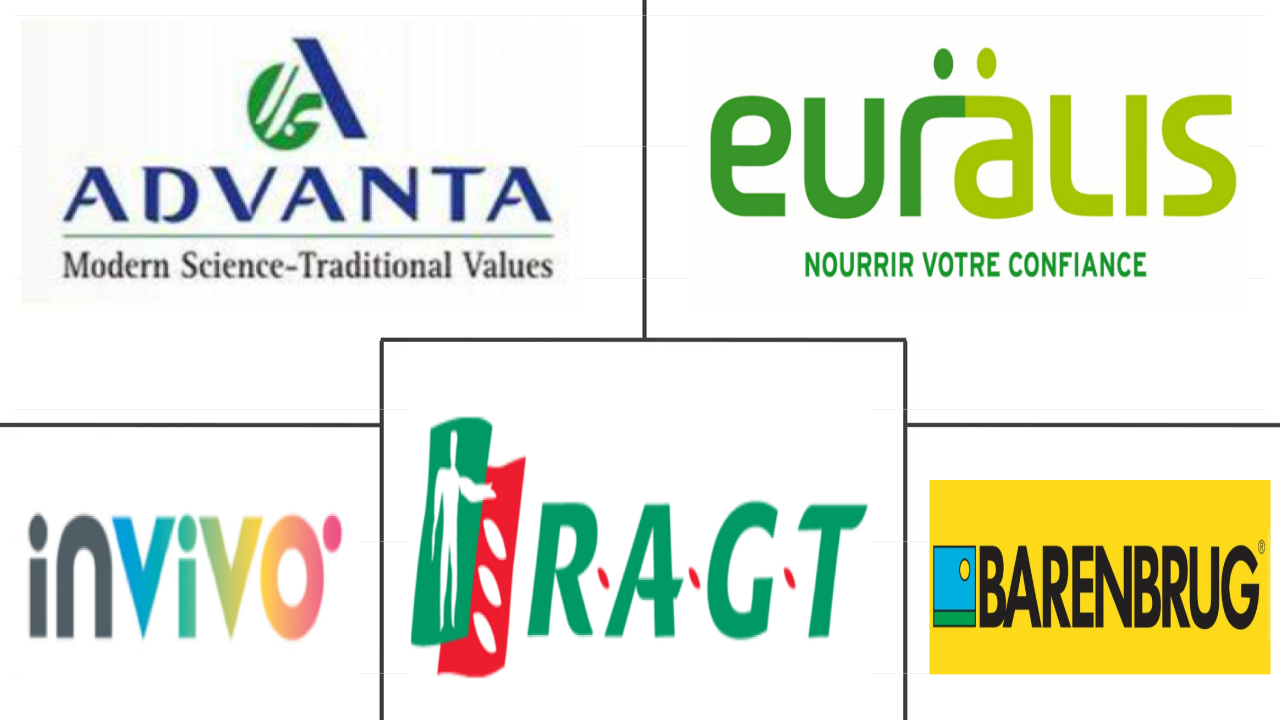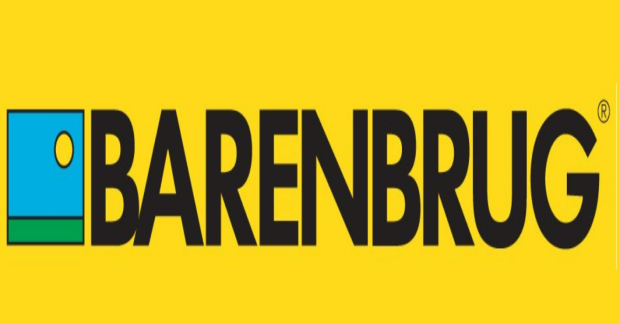Market Size of europe forage seed Industry
|
|
Study Period | 2017 - 2030 |
|
|
Market Size (2024) | USD 1.27 Billion |
|
|
Market Size (2030) | USD 1.6 Billion |
|
|
Largest Share by Breeding Technology | Hybrids |
|
|
CAGR (2024 - 2030) | 3.96 % |
|
|
Largest Share by Country | France |
Major Players |
||

|
||
|
*Disclaimer: Major Players sorted in no particular order |
Europe Forage Seed Market Analysis
The Europe Forage Seed Market size is estimated at 1.27 billion USD in 2024, and is expected to reach 1.6 billion USD by 2030, growing at a CAGR of 3.96% during the forecast period (2024-2030).
1.27 Billion
Market Size in 2024 (USD)
1.6 Billion
Market Size in 2030 (USD)
2.90 %
CAGR (2017-2023)
3.96 %
CAGR (2024-2030)
Largest Market by Crop
63.56 %
value share, Forage Corn, 2023
Europe witnessed an increase in the demand for forage corn seeds due to an increase in the demand for feed by dairy farmers and an increase in the production of biogas.
Largest Market by Country
29.21 %
value share, France, 2023
In France, a surge in livestock populations and a rising need for feed are fueling market growth. This, in turn, boosted forage crop cultivation and higher demand for forage seeds.
Fastest-growing Market by Crop
7.10 %
Projected CAGR, Forage Sorghum, 2024-2030
The increased adoption of forage sorghum in Europe can be attributed to its fast growth, resilience, and suitability for livestock feed, resulting in a rise in seed demand.
Fastest-growing Market by Country
6 %
Projected CAGR, United Kingdom, 2024-2030
The United Kingdom has a high demand for forage crops due to increased livestock farming, favorable climatic conditions, and growing demand for high-quality animal feed.
Leading Market Player
7.44 %
market share, Royal Barenbrug Group, 2022

The company has made a strategic partnership with S&W to acquire a license to distribute forage seeds in the European region and introduce new corn silage seeds.
Hybrid forage seeds dominated the market due to their traits such as increased yield, disease resistance, and widely adaptable nature
- In 2022, hybrids dominated the European forage seed market and accounted for about 88% of the market. Open-pollinated varieties accounted for 12% in the same year. The high share of hybrids is associated with traits such as high yield, disease resistance, high vigor, and wider adaptability. Only non-transgenic hybrid varieties are approved for cultivation due to the ban on genetically engineered crops in the region.
- In 2022, forage corn held the major share of 62.9% in the hybrids segment due to the large area under cultivation and higher adoption of hybrids. The volume of corn hybrid seeds increased by 2.1% in 2022 compared to 2021, primarily due to increased forage demand from large commercial dairy farms.
- Alfalfa held a share value of 36% in the European hybrid forage seed market in 2022 due to the high seed replacement rate and high demand from the livestock industry, which may further increase the sales of hybrid seeds during the forecast period.
- Europe is one of the largest producers of non-transgenic hybrid forage corn, contributing an 88% share value of the European forage seed market in 2022. The demand for non-transgenic, hybrid forage corn seeds in the region may increase further during the forecast period due to their high nutritional value.
- Germany was the major country in terms of area under OPVs. In 2022, the country had a 33.2% area of the total European forage OPVs and hybrid derivatives due to the prevalence of native pastures in the country. The use of OPVs lowers cultivation costs, which is likely to boost their use in the future.
- Therefore, both hybrid and OPV seed varieties are anticipated to grow during the forecast period due to increased demand from the livestock sector.
Germany is leading in forage seed sales with high demand from the processing industry and increasing demand for animal feed
- Europe is one of the significant producers of forage crops. In 2022, the market accounted for 8.8% of the European seed market and 26.7% of the global forage seed market by value. The market is being driven by the increasing animal population and rising meat consumption.
- To meet the growing demand for high forage quality and shorter harvest time periods, companies have been developing new seed varieties for the benefit of growers. For instance, farmers now have access to alfalfa varieties such as DKC 3218, DKC 3204, Debalto, and Marcamo.
- France had the highest sales of forage seeds in Europe, with a market share of 28.6% in 2022, followed by Germany, with 20.4%. The driving factors include growing demand for feed products, consumer demand for livestock products, an increase in the livestock population, and shrinking land for grazing animals.
- The United Kingdom is one of the fastest-growing countries, with a projected CAGR of 5.9% during the forecast period due to high demand for forage from livestock farmers and the country witnessing an increase in biofuel production and pig population.
- Other countries such as Italy, the Netherlands, and Poland also have a significant demand for forage crops, and the area harvested in these countries increased by 6.8% from 2017 to 2022.
- The European Seed Association's regulation, which governs the forage seed market, helped increase investments in forage seed production to enhance the unpredictability of the seed cycle, soil conditions, and time incentive returns. Therefore, the forage seed market in the region is estimated to register a CAGR of 3.9% during the forecast period.
Europe Forage Seed Industry Segmentation
Hybrids, Open Pollinated Varieties & Hybrid Derivatives are covered as segments by Breeding Technology. Alfalfa, Forage Corn, Forage Sorghum are covered as segments by Crop. France, Germany, Italy, Netherlands, Poland, Romania, Russia, Spain, Turkey, Ukraine, United Kingdom are covered as segments by Country.
- In 2022, hybrids dominated the European forage seed market and accounted for about 88% of the market. Open-pollinated varieties accounted for 12% in the same year. The high share of hybrids is associated with traits such as high yield, disease resistance, high vigor, and wider adaptability. Only non-transgenic hybrid varieties are approved for cultivation due to the ban on genetically engineered crops in the region.
- In 2022, forage corn held the major share of 62.9% in the hybrids segment due to the large area under cultivation and higher adoption of hybrids. The volume of corn hybrid seeds increased by 2.1% in 2022 compared to 2021, primarily due to increased forage demand from large commercial dairy farms.
- Alfalfa held a share value of 36% in the European hybrid forage seed market in 2022 due to the high seed replacement rate and high demand from the livestock industry, which may further increase the sales of hybrid seeds during the forecast period.
- Europe is one of the largest producers of non-transgenic hybrid forage corn, contributing an 88% share value of the European forage seed market in 2022. The demand for non-transgenic, hybrid forage corn seeds in the region may increase further during the forecast period due to their high nutritional value.
- Germany was the major country in terms of area under OPVs. In 2022, the country had a 33.2% area of the total European forage OPVs and hybrid derivatives due to the prevalence of native pastures in the country. The use of OPVs lowers cultivation costs, which is likely to boost their use in the future.
- Therefore, both hybrid and OPV seed varieties are anticipated to grow during the forecast period due to increased demand from the livestock sector.
| Breeding Technology | |||
| |||
| Open Pollinated Varieties & Hybrid Derivatives |
| Crop | |
| Alfalfa | |
| Forage Corn | |
| Forage Sorghum | |
| Other Forage Crops |
| Country | |
| France | |
| Germany | |
| Italy | |
| Netherlands | |
| Poland | |
| Romania | |
| Russia | |
| Spain | |
| Turkey | |
| Ukraine | |
| United Kingdom | |
| Rest of Europe |
Europe Forage Seed Market Size Summary
The Europe forage seed market is experiencing steady growth, driven by increasing demand from the livestock sector and the need for high-quality animal feed. The market is characterized by a significant presence of hybrid seed varieties, which dominate due to their high yield, disease resistance, and adaptability. The region's focus on non-transgenic hybrids aligns with regulatory restrictions on genetically engineered crops, further boosting the demand for these seeds. Forage corn and alfalfa are the most cultivated crops, with their extensive use attributed to their nutritional value and suitability for livestock feed. The market's expansion is supported by advancements in seed technology and breeding techniques, aimed at enhancing crop yield and quality to meet the rising feed demand.
Europe's forage seed market is a crucial segment of the global agricultural landscape, contributing significantly to both the European and global seed markets. The region's diverse climate and landscape provide an ideal environment for forage cultivation, with countries like Germany and France leading in production. The market is fragmented, with major players actively engaging in strategic acquisitions and partnerships to strengthen their market position. The increasing area under cultivation, driven by the rising livestock population and shrinking grazing lands, underscores the market's potential for growth. As the demand for robust and high-starch forage varieties grows, companies are focusing on developing seeds that offer early maturity and resilience to environmental stresses, ensuring a steady supply of quality forage to meet future consumption needs.
Europe Forage Seed Market Size - Table of Contents
-
1. MARKET SEGMENTATION (includes market size in Value in USD, Forecasts up to 2030 and analysis of growth prospects)
-
1.1 Breeding Technology
-
1.1.1 Hybrids
-
1.1.1.1 Non-Transgenic Hybrids
-
-
1.1.2 Open Pollinated Varieties & Hybrid Derivatives
-
-
1.2 Crop
-
1.2.1 Alfalfa
-
1.2.2 Forage Corn
-
1.2.3 Forage Sorghum
-
1.2.4 Other Forage Crops
-
-
1.3 Country
-
1.3.1 France
-
1.3.2 Germany
-
1.3.3 Italy
-
1.3.4 Netherlands
-
1.3.5 Poland
-
1.3.6 Romania
-
1.3.7 Russia
-
1.3.8 Spain
-
1.3.9 Turkey
-
1.3.10 Ukraine
-
1.3.11 United Kingdom
-
1.3.12 Rest of Europe
-
-
Europe Forage Seed Market Size FAQs
How big is the Europe Forage Seed Market?
The Europe Forage Seed Market size is expected to reach USD 1.27 billion in 2024 and grow at a CAGR of 3.96% to reach USD 1.60 billion by 2030.
What is the current Europe Forage Seed Market size?
In 2024, the Europe Forage Seed Market size is expected to reach USD 1.27 billion.

